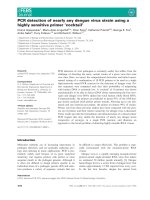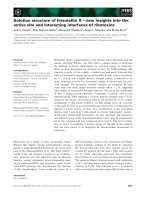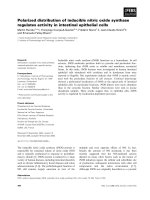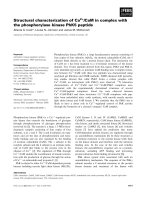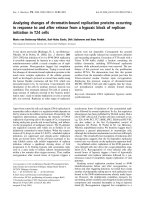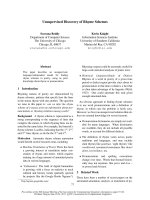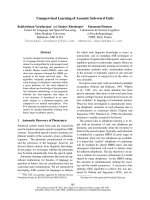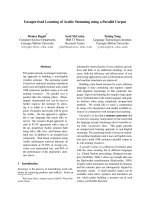Báo cáo khoa học: "Unsupervised Induction of Modern Standard Arabic Verb Classes Using Syntactic Frames and LSA" pdf
Bạn đang xem bản rút gọn của tài liệu. Xem và tải ngay bản đầy đủ của tài liệu tại đây (187.46 KB, 8 trang )
Proceedings of the COLING/ACL 2006 Main Conference Poster Sessions, pages 795–802,
Sydney, July 2006.
c
2006 Association for Computational Linguistics
Unsupervised Induction of Modern Standard Arabic Verb Classes Using
Syntactic Frames and LSA
Neal Snider
Linguistics Department
Stanford University
Stanford, CA 94305
Mona Diab
Center for Computational Learning Systems
Columbia University
New York, NY 10115
Abstract
We exploit the resources in the Arabic
Treebank (ATB) and Arabic Gigaword
(AG) to determine the best features for the
novel task of automatically creating lexi-
cal semantic verb classes for Modern Stan-
dard Arabic (MSA). The verbs are clas-
sified into groups that share semantic el-
ements of meaning as they exhibit simi-
lar syntactic behavior. The results of the
clustering experiments are compared with
a gold standard set of classes, which is
approximated by using the noisy English
translations provided in the ATB to cre-
ate Levin-like classes for MSA. The qual-
ity of the clusters is found to be sensitive
to the inclusion of syntactic frames, LSA
vectors, morphological pattern, and sub-
ject animacy. The best set of parameters
yields an F
β=1
score of 0.456, compared
to a random baseline of an F
β=1
score of
0.205.
1 Introduction
The creation of the Arabic Treebank (ATB) and
Arabic Gigaword (AG) facilitates corpus based
studies of many interesting linguistic phenomena
in Modern Standard Arabic (MSA).
1
The ATB
comprises manually annotated morphological and
syntactic analyses of newswire text from different
Arabic sources, while the AG is simply a huge col-
lection of raw Arabic newswire text. In our on-
going project, we exploit the ATB and AG to de-
termine the best features for the novel task of au-
tomatically creating lexical semantic verb classes
1
/>for MSA. We are interested in the problem of clas-
sifying verbs in MSA into groups that share se-
mantic elements of meaning as they exhibit simi-
lar syntactic behavior. This manner of classifying
verbs in a language is mainly advocated by Levin
(1993). The Levin Hypothesis (LH) contends that
verbs that exhibit similar syntactic behavior share
element(s) of meaning. There exists a relatively
extensive classification of English verbs according
to different syntactic alternations. Numerous lin-
guistic studies of other languages illustrate that LH
holds cross linguistically, in spite of variations in
the verb class assignment. For example, in a wide
cross-linguistic study, Guerssel et al (1985) found
that the Conative Alternation exists in the Aus-
tronesian language Warlpiri. As in English, the
alternation is found with hit- and cut-type verbs,
but not with touch- and break-type verbs.
A strong version of the LH claims that compara-
ble syntactic alternations hold cross-linguistically.
Evidence against this strong version of LH is pre-
sented by Jones et al (1994). For the purposes of
this paper, we maintain that although the syntac-
tic alternations will differ across languages, the se-
mantic similarities that they signal will hold cross
linguistically. For Arabic, a significant test of LH
has been the work of Fareh and Hamdan (2000),
who argue the existence of the Locative Alterna-
tion in Jordanian Arabic. However, to date no gen-
eral study of MSA verbs and alternations exists.
We address this problem by automatically induc-
ing such classes, exploiting explicit syntactic and
morphological information in the ATB using un-
supervised clustering techniques.
This paper is an extension of our previous work
in Snider and Diab (2006), which found a prelim-
inary effect of syntactic frames on the precision
of MSA verb clustering. In this work, we find
795
effects of three more features, and report results
using both precision and recall. This project is
inspired by previous approaches to automatically
induce lexical semantic classes for English verbs,
which have met with success (Merlo and Steven-
son, 2001; Schulte im Walde, 2000) , compar-
ing their results with manually created Levin verb
classes. However, Arabic morphology has well
known correlations with the kind of event struc-
ture that forms the basis of the Levin classification.
(Fassi-Fehri, 2003). This characteristic of the lan-
guage makes this a particularly interesting task to
perform in MSA. Thus, the scientific goal of this
project is to determine the features that best aid
verb clustering, particularly the language-specific
features that are unique to MSA and related lan-
guages.
Inducing such classes automatically allows for
a large-scale study of different linguistic phenom-
ena within the MSA verb system, as well as cross-
linguistic comparison with their English coun-
terparts. Moreover, drawing on generalizations
yielded by such a classification could potentially
be useful in several NLP problems such as Infor-
mation Extraction, Event Detection, Information
Retrieval and Word Sense Disambiguation, not to
mention the facilitation of lexical resource cre-
ation such as MSA WordNets and ontologies.
Unfortunately, a gold standard resource compa-
rable to Levin’s English classification for evalua-
tion does not exist in MSA. Therefore, in this pa-
per, as before, we evaluate the quality of the au-
tomatically induced MSA verb classes both qual-
itatively and quantitatively against a noisy MSA
translation of Levin classes in an attempt to create
such classes for MSA verbs.
The paper is organized as follows: Section 2
describes Levin classes for English; Section 3 de-
scribes some relevant previous work; In Section
4 we discuss relevant phenomena of MSA mor-
phology and syntax; In Section 5, we briefly de-
scribe the clustering algorithm; Section 6 gives a
detailed account of the features we use to induce
the verb clusters; Then, Section 7, describes our
evaluation data, metric, gold standard and results;
In Section 8, we discuss the results and draw on
some quantitative and qualitative observations of
the data; Finally, we conclude this paper in Section
9 with concluding remarks and a look into future
directions.
2 Levin Classes
The idea that verbs form lexical semantic clus-
ters based on their syntactic frames and argu-
ment selection preferences is inspired by the work
of Levin, who defined classes of verbs based on
their syntactic alternation behavior. For example,
the class Vehicle Names (e.g. bicycle, canoe,
skate, ski) is defined by the following syntactic al-
ternations (among others):
1. INTRANSITIVE USE, optionally followed by
a path
They skated (along the river bank).
2. INDUCED ACTION (some verbs)
Pat skated (Kim) around the rink.
Levin lists 184 manually created classes for En-
glish, which is not intended as an exhaustive clas-
sification. Many verbs are in multiple classes
both due to the inherent polysemy of the verbs
as well as other aspectual variations such as ar-
gument structure preferences. As an example of
the latter, a verb such as eat occurs in two differ-
ent classes; one defined by the Unspecified Ob-
ject Alternation where it can appear both with and
without an explicit direct object, and another de-
fined by the Connative Alternation where its sec-
ond argument appears either as a direct object
or the object of the preposition at. It is impor-
tant to note that the Levin classes aim to group
verbs based on their event structure, reflecting as-
pectual and manner similarities rather than sim-
ilarity due to their describing the same or simi-
lar events. Therefore, the semantic class similar-
ity in Levin classes is coarser grained than what
one would expect resulting from a semantic clas-
sification based on distributional similarity such as
Latent Semantic Analysis (LSA) algorithms. For
illustration, one would expect an LSA algorithm
to group skate, rollerblade in one class and bicy-
cle, motorbike, scooter in another; yet Levin puts
them all in the same class based on their syntactic
behavior, which reflects their common event struc-
ture: an activity with a possible causative partici-
pant. One of the purposes of this work is to test
this hypothesis by examining the relative contri-
butions of LSA and syntactic frames to verb clus-
tering.
3 Related Work
Based on the Levin classes, many researchers at-
tempt to induce such classes automatically. No-
796
tably the work of Merlo and Stevenson (2001) at-
tempts to induce three main English verb classes
on a large scale from parsed corpora, the class
of Ergative, Unaccusative, and Object-drop verbs.
They report results of 69.8% accuracy on a task
whose baseline is 34%, and whose expert-based
upper bound is 86.5%. In a task similar to ours
except for its use of English, Schulte im Walde
clusters English verbs semantically by using their
alternation behavior, using frames from a statisti-
cal parser combined with WordNet classes. She
evaluates against the published Levin classes, and
reports that 61% of all verbs are clustered into cor-
rect classes, with a baseline of 5%.
4 Arabic Linguistic Phenomena
In this paper, the language of interest is MSA.
Arabic verbal morphology provides an interesting
piece of explicit lexical semantic information in
the lexical form of the verb. Arabic verbs have two
basic parts, the root and pattern/template, which
combine to form the basic derivational form of a
verb. Typically a root consists of three or four con-
sonants, referred to as radicals. A pattern, on the
other hand, is a distribution of vowel and conso-
nant affixes on the root resulting in Arabic deriva-
tional lexical morphology. As an example, the root
k t b,
2
if interspersed with the pattern 1a2a3 – the
numbers correspond to the positions of the first,
second and third radicals in the root, respectively
– yields katab meaning write. However, if the pat-
tern were ma1A2i3, resulting in the word makAtib,
it would mean offices/desks or correspondences.
There are fifteen pattern forms for MSA verbs, of
which ten are commonly used. Not all verbs occur
with all ten patterns. These root-pattern combina-
tions tend to indicate a particular lexical semantic
event structure in the verb.
5 Clustering
Taking the linguistic phenomena of MSA as fea-
tures, we apply clustering techniques to the prob-
lem of inducing verb classes. We showed in Snider
& Diab (2006) that soft clustering performs best
on this task compared to hard clustering, therefore
we employ soft clustering techniques to induce the
verb classes here. Clustering algorithms partition
a set of data into groups, or clusters based on a
similarity metric. Soft clustering allows elements
2
All Arabic in the paper is rendered in the Buckwalter
transliteration scheme http:://www.ldc.upenn.edu.
to be members of multiple clusters simultaneously,
and have degrees of membership in all clusters.
This membership is sometimes represented in a
probabilistic framework by a distribution P (x
i
, c),
which characterizes the probability that a verb x
i
is a member of cluster c.
6 Features
Syntactic frames The syntactic frames are de-
fined as the sister constituents of the verb in a Verb
Phrase (VP) constituent, namely, Noun Phrases
(NP), Prepositional Phrases (PP), and Sentential
Complements (SBARs and Ss). Not all of these
constituents are necessarily arguments of the verb,
so we take advantage of functional tag annota-
tions in the ATB. Hence, we only include NPs
with function annotation: subjects (NP-SBJ), top-
icalized subjects (NP-TPC),
3
objects (NP-OBJ),
and second objects in dative constructions (NP-
DTV). The PPs deemed relevant to the particular
sense of the verb are tagged by the ATB annota-
tors as PP-CLR. We assume that these are argu-
ment PPs, and include them in our frames. Fi-
nally, we include sentential complements (SBAR
and S). While some of these will no doubt be ad-
juncts (i.e. purpose clauses and the like), we as-
sume that those that are arguments will occur in
greater numbers with particular verbs, while ad-
juncts will be randomly distributed with all verbs.
Given Arabic’s somewhat free constituent or-
der, frames are counted as the same when they
contain the same constituents, regardless of order.
Also, for each constituent that is headed by a func-
tion word (PPs and SBARs) such as prepositions
and complementizers, the headword is extracted
to include syntactic alternations that are sensitive
to preposition or complementizer type. It is worth
noting that this corresponds to the FRAME1 con-
figuration described in our previous study.(Snider
and Diab, 2006) Finally, only active verbs are in-
cluded in this study, rather than attempt to recon-
struct the argument structure of passives.
Verb pattern The ATB includes morphological
analyses for each verb resulting from the Buck-
walter Analyzer (BAMA).
4
For each verb, one
of the analyses resulting from BAMA is chosen
manually by the treebankers. The analyses are
3
These are displaced NP-SBJ marked differently in the
ATB to indicate SVO order rather than the canonical VSO
order in MSA. NP-TPC occurs in 35% of the ATB.
4
797
matched with the root and pattern information de-
rived manually in a study by Nizar Habash (per-
sonal communication).This feature is of particular
scientific interest because it is unique to Semitic
languages, and, as mentioned above, has an inter-
esting potential correlation with argument struc-
ture.
Subject animacy In an attempt to allow the clus-
tering algorithm to use information closer to actual
argument structure than mere syntactic frames, we
add a feature that indicates whether a verb re-
quires an animate subject. Merlo and Stevenson
(2001) found that this feature improved their En-
glish verb clusters, but in Snider & Diab (2006),
we found this feature to not contribute signifi-
cantly to Arabic verb clustering quality. How-
ever, upon further inspection of the data, we dis-
covered we could improve the quality of this fea-
ture extraction in this study. Automatically deter-
mining animacy is difficult because it requires ex-
tensive manual annotation or access to an exter-
nal resource such as WordNet, neither of which
currently exist for Arabic. Instead we rely on an
approximation that takes advantage of two gen-
eralizations from linguistics: the animacy hierar-
chy and zero-anaphora. According to the animacy
hierarchy, as described in Silverstein (1976), pro-
nouns tend to describe animate entities. Follow-
ing a technique suggested by Merlo and Steven-
son(2001), we take advantage of this tendency
by adding a feature that is the number of times
each verb occurs with a pronominal subject. We
also take advantage of the phenomenon of zero-
anaphora, or pro-drop, in Arabic as an additional
indicator subject animacy. Pro-drop is a common
phenomenon in Romance languages, as well as
Semitic languages, where the subject is implicit
and the only indicator of a subject is incorporated
in the conjugation of the verb. According to work
on information structure in discourse (Vallduv
´
ı,
1992), pro-drop tends to occur with more given
and animate subjects. To capture this generaliza-
tion, we add a feature for the frequency with which
a given verb occurs without an explicit subject. We
further hypothesize that proper names are more
likely to describe animates (humans, or organiza-
tions which metonymically often behave like an-
imates), adding a feature for the frequency with
which a given verb occurs with a proper name.
With these three features, we provide the cluster-
ing algorithm with subject animacy indicators.
LSA semantic vector This feature is the semantic
vector for each verb, as derived by Latent Seman-
tic Analysis (LSA) of the AG. LSA is a dimension-
ality reduction technique that relies on Singular
Value Decomposition (SVD) (Landauer and Du-
mais, 1997). The main strength in applying LSA
to large quantities of text is that it discovers the
latent similarities between concepts. It may be
viewed as a form of clustering in conceptual space.
7 Evaluation
7.1 Data Preparation
The four sets of features are cast as the column
dimensions of a matrix, with the MSA lemma-
tized verbs constituting the row entries. The data
used for the syntactic frames is obtained from
the ATB corresponding to ATB1v3, ATB2v2 and
ATB3v2. The ATB is a collection of 1800 sto-
ries of newswire text from three different press
agencies, comprising a total of 800, 000 Arabic
tokens after clitic segmentation. The domain of
the corpus covers mostly politics, economics and
sports journalism. To extract data sets for the
frames, the treebank is first lemmatized by looking
up lemma information for each word in its man-
ually chosen (information provided in the Tree-
bank files) corresponding output of BAMA. Next,
each active verb is extracted along with its sister
constituents under the VP in addition to NP-TPC.
As mentioned above, the only constituents kept
as the frame are those labeled NP-TPC, NP-SBJ,
NP-OBJ, NP-DTV, PP-CLR, and SBAR. For PP-
CLRs and SBARs, the head preposition or com-
plementizer which is assumed to be the left-most
daughter of the phrase, is extracted. The verbs
and frames are put into a matrix where the row
entries are the verbs and the column entries are
the frames. The elements of the matrix are the
frequency of the row verb occurring in a given
frame column entry. There are 2401 verb types
and 320 frame types, corresponding to 52167 total
verb frame tokens.
For the LSA feature, we apply LSA to the AG
corpus. AG (GIGAWORD 2) comprises 481 mil-
lion words of newswire text. The AG corpus
is morphologically disambiguated using MADA.
5
MADA is an SVM based system that disam-
biguates among different morphological analyses
produced by BAMA.(Habash and Rambow, 2005)
We extract the lemma forms of all the words in AG
5
/>798
and use them for the LSA algorithm. To extract the
LSA vectors, first the lemmatized AG data is split
into 100 sentence long pseudo-documents. Next,
an LSA model is trained using the Infomap soft-
ware
6
on half of the AG (due to size limitations
of Infomap). Infomap constructs a word similarity
matrix in document space, then reduces the dimen-
sionality of the data using SVD. LSA reduces AG
to 44 dimensions. The 44-dimensional vector is
extracted for each verb, which forms the LSA data
set for clustering.
Subject animacy information is represented as
three feature columns in our matrix. One column
entry represents the frequency a verb co-occurs
with an empty subject (represented as an NP-SBJ
dominating the NONE tag, 21586 tokens). An-
other column has the frequency the NP-SBJ/NP-
TPC dominates a pronoun (represented in the cor-
pus as the tag PRON 3715 tokens). Finally, the
last subject animacy column entry represents the
frequency an NP-SBJ/NP-TPC dominates a proper
name (tagged NOUN
PROP, 4221 tokens).
The morphological pattern associated with each
verb is extracted by looking up the lemma in
the output of BAMA. The pattern information is
added as a feature column to our matrix of verbs
by features.
7.2 Gold Standard Data
The gold standard data is created automatically
by taking the English translations corresponding
to the MSA verb entries provided with the ATB
distributions. We use these English translations
to locate the lemmatized MSA verbs in the Levin
English classes represented in the Levin Verb In-
dex (Levin, 1993), thereby creating an approxi-
mated MSA set of verb classes corresponding to
the English Levin classes. Admittedly, this is a
crude manner to create a gold standard set. Given
lack of a pre-existing classification for MSA verbs,
and the novelty of the task, we consider it a first
approximation step towards the creation of a real
gold standard classification set in the near future.
Since the translations are assigned manually to the
verb entries in the ATB, we assume that they are a
faithful representation of the MSA language used.
Moreover, we contend that lexical semantic mean-
ings, if they hold cross linguistically, would be
defined by distributions of syntactic alternations.
Unfortunately, this gold standard set is more noisy
6
/>than expected due to several factors: each MSA
morphological analysis in the ATB has several
associated translations, which include both poly-
semy and homonymy. Moreover, some of these
translations are adjectives and nouns as well as
phrasal expressions. Such divergences occur natu-
rally but they are rampant in this data set. Hence,
the resulting Arabic classes are at a finer level
of granularity than their English counterparts be-
cause of missing verbs in each cluster. There are
also many gaps – unclassified verbs – when the
translation is not a verb, or a verb that is not in
the Levin classification. Of the 480 most frequent
verb types used in this study, 74 are not in the
translated Levin classification.
7.3 Clustering Algorithms
We use the clustering algorithms implemented
in the library cluster (Kaufman and Rousseeuw,
1990) in the R statistical computing language. The
soft clustering algorithm, called FANNY, is a type
of fuzzy clustering, where each observation is
“spread out” over various clusters. Thus, the out-
put is a membership function P (x
i
, c), the mem-
bership of element x
i
to cluster c. The member-
ships are nonnegative and sum to 1 for each fixed
observation. The algorithm takes k, the number
of clusters, as a parameter and uses a Euclidean
distance measure. We determine k empirically, as
explained below.
7.4 Evaluation Metric
The evaluation metric used here is a variation on
an F -score derived for hard clustering (Chklovski
and Mihalcea, 2003). The result is an F
β
measure,
where β is the coefficient of the relative strengths
of precision and recall. β = 1 for all results we
report. The score measures the maximum over-
lap between a hypothesized cluster (HYP) and a
corresponding gold standard cluster (GOLD), and
computes a weighted average across all the GOLD
clusters:
F
β
=
C∈C
C
V
tot
max
A∈A
(β
2
+ 1)A ∩ C
β
2
C + A
A is the set of HYP clusters, C is the set of
GOLD clusters, and V
tot
=
C∈C
C is the total
number of verbs to be clustered. This is the mea-
sure that we report, which weights precision and
recall equally.
799
7.5 Results
To determine the features that yield the best clus-
tering of the extracted verbs, we run tests com-
paring seven different factors of the model, in a
2x2x2x2x3x3x5 design, with the first four param-
eters being the substantive informational factors,
and the last three being parameters of the clus-
tering algorithm. For the feature selection experi-
ments, the informational factors all have two con-
ditions, which encode the presence or absence of
the information associated with them. The first
factor represents the syntactic frame vectors, the
second the LSA semantic vectors, the third the
subject animacy, and the fourth the morphological
pattern of the verb.
The fifth through seventh factors are parame-
ters of the clustering algorithm: The fifth factor
is three different numbers of verbs clustered: the
115, 268, and 406 most frequent verb types, re-
spectively. The sixth factor represents numbers
of clusters (k). These values are dependent on
the number of verbs tested at a time. Therefore,
this factor is represented as a fraction of the num-
ber of verbs. Hence, the chosen values are
1
6
,
1
3
,
and
1
2
of the number of verbs. The seventh and
last factor is a threshold probability used to derive
discrete members for each cluster from the clus-
ter probability distribution as rendered by the soft
clustering algorithm. In order to get a good range
of the variation in the effect of the threshold, we
empirically choose five different threshold values:
0.03, 0.06, 0.09, 0.16, and 0.21. The purpose of
the last three factors is to control for the amount
of variation introduced by the parameters of the
clustering algorithm, in order to determine the ef-
fect of the informational factors. Evaluation scores
are obtained for all combinations of all seven fac-
tors (minus the no information condition - the al-
gorithm must have some input!), resulting in 704
conditions.
We compare our best results to a random base-
line. In the baseline, verbs are randomly assigned
to clusters where a random cluster size is on av-
erage the same size as each other and as GOLD.
7
The highest overall scored F
β=1
is 0.456 and it
results from using syntactic frames, LSA vectors,
subject animacy, 406 verbs, 202 clusters, and a
threshold of 0.16. The average cluster size is 3,
7
It is worth noting that this gives an added advantage to
the random baseline, since a comparable to GOLD size im-
plicitly contibutes to a higher overlap score.
because this is a soft clustering. The random base-
line achieves an overall F
β=1
of 0.205 with com-
parable settings of 406 verbs randomly assigned to
202 clusters of approximately equal size.
To determine which features contribute signif-
icantly to clustering quality, a statistical analysis
of the clustering experiments is undertaken in the
next section.
8 Discussion
For further quantitative error analysis of the data
and feature selection, we perform an ANOVA to
test the significance of the differences among in-
formation factors and the various parameter set-
tings of the clustering algorithm. This error anal-
ysis uses the error metric from Snider & Diab
(2006) that allows us to test just the HYP verbs
that match the GOLD set. The emphasis on preci-
sion in the feature selection serves the purpose of
countering the large underestimation of recall that
is due to a noisy gold standard. We believe that
the features that are found to be significant by this
metric stand the best chance of being useful once
a better gold standard is available.
The ANOVA analyzes the effects of syntactic
frame, LSA vectors, subject animacy, verb pattern,
verb number, cluster number, and threshold. Syn-
tactic frame information contributes positively to
clustering quality (p < .03), as does LSA (p <
.001). Contrary to the result in Snider & Diab
(2006), subject animacy has a significant positive
contribution (p < .002). Interestingly, the mor-
phological pattern contributes negatively to clus-
tering quality (p < .001). As expected, the control
parameters all have a significant effect: number of
verbs (p < .001), number of clusters (p < .001),
and threshold (p < .001).
As evident from the results of the statistical
analysis, the various informational factors have an
interesting effect on the quality of the clusters.
Both syntactic frames and LSA vectors contribute
independently to clustering quality. This indicates
that successfully clustering verbs requires infor-
mation at the relatively coarse level of event struc-
ture, as well as the finer grained semantics pro-
vided by word co-occurrence techniques such as
LSA.
Subject animacy is found to improve clustering,
which is consistent with the results for English
found by Merlo and Stevenson. This is definite im-
provement over our previous study, and indicates
800
that the extraction of the feature has been much
improved.
Most interesting from a linguistic perspective is
the finding that morphological pattern information
about the verb actually worsens clustering qual-
ity. This could be explained by the fact that the
morphological patterns are productive, so that two
different verb lemmas actually describe the same
event structure. This would worsen the cluster-
ing because these morphological alternations that
are represented by the different patterns actually
change the lemma form of the verb, unlike syntac-
tic alternations. If only syntactic alternation fea-
tures are taken into account, the different pattern
forms of the same root could still be clustered to-
gether; however, our design of the pattern feature
does not allow for variation in the lemma form,
therefore, we are in effect preventing the useful ex-
ploitation of the pattern information. Further evi-
dence comes from the positive effect of the LSA
feature, which effectively clusters together these
productive patterns hence yielding the significant
impact on the clustering.
Overall, the scores that we report use the eval-
uation metric that equally weights precision and
recall. This metric disfavors clusters that are too
large or too small. Models perform better when
the average size of HYP is the same as that of
GOLD. It is worth noting that comparing our cur-
rent results to those obtained in Snider & Diab
(2006), we show a significant improvement given
the same precision oriented metric. In the same
condition settings, our previous results are an F
β
score of 0.51 and in this study, a precision oriented
metric yields a significant improvement of 17 ab-
solute points, at an F
β
score of 0.68. Even though
we do not report this number as the main result of
our study, we tend to have more confidence in it
due to the noise associated with the GOLD set.
The score of the best parameter settings with re-
spect to the baseline is considerable given the nov-
elty of the task and lack of good quality resources
for evaluation. Moreover, there is no reason to
expect that there would be perfect alignment be-
tween the Arabic clusters and the corresponding
translated Levin clusters, primarily because of the
quality of the translation, but also because there
is unlikely to be an isomorphism between English
and Arabic lexical semantics, as assumed here as
a means of approximating the problem. In fact, it
would be quite noteworthy if we did find a high
level of agreement.
In an attempt at a qualitative analysis of the re-
sulting clusters, we manually examine four HYP
clusters.
• The first cluster includes the verbs >aloqaY
[meet], $ahid [view], >ajoraY [run an inter-
view], {isotaqobal [receive a guest], Eaqad
[hold a conference], >aSodar [issue]. We
note that they all share the concept of con-
vening, or formal meetings. The verbs are
clearly related in terms of their event struc-
ture (they are all activities, without an associ-
ated change of state) yet are not semantically
similar. Therefore, our clustering approach
yields a classification that is on par with the
Levin classes in the coarseness of the cluster
membership granularity.
• The second consists of ∗akar [mention],
>afAd [report] which is evaluated against
the GOLD cluster class comprising the verbs
>aEolan [announce], >a$Ar [indicate],
∗akar [mention], >afAd [report], Sar∼aH
[report/confirm], $ahid [relay/witness],
ka$af [uncover] corresponding to the Say
Verb Levin class. The HYP cluster, though
correct, loses significantly on recall. This
is due to the low frequency of some of the
verbs in the GOLD set, which in turn affects
the overall score of this HYP cluster.
• Finally, the HYP cluster comprising Eamil
[work continuously on], jA’ [occur],
{isotamar [continue], zAl [remain], baqiy
[remain], jaraY [occur] corresponds to the
Occurrence Verb Levin class. The
corresponding GOLD class comprises jA’
[occur], HaSal [happen], jaraY [occur]. The
HYP cluster contains most of the relevant
verbs and adds others that would fall in that
same class such as {isotamar [continue],
zAl [remain], baqiy [remain], since they
have similar syntactic diagnostics where they
do not appear in the transitive uses and with
locative inversions. However they are not
found in the Levin English class since it is
not a comprehensive listing of all English
verbs.
In summary, we observe very interesting clus-
ters of verbs which indeed require more in depth
lexical semantic study as MSA verbs in their own
right.
801
9 Conclusions
We found new features that help us successfully
perform the novel task of applying clustering tech-
niques to verbs acquired from the ATB and AG to
induce lexical semantic classes for MSA verbs. In
doing this, we find that the quality of the clusters
is sensitive to the inclusion of information about
the syntactic frames, word co-occurence (LSA),
and animacy of the subject, as well as parame-
ters of the clustering algorithm such as the number
of clusters, and number of verbs clustered. Our
classification performs well with respect to a gold
standard clusters produced by noisy translations of
English verbs in the Levin classes. Our best clus-
tering condition when we use all frame informa-
tion and the most frequent verbs in the ATB and
a high number of clusters outperforms a random
baseline by F
β=1
difference of 0.251. This anal-
ysis leads us to conclude that the clusters are in-
duced from the structure in the data
Our results are reported with a caveat on the
gold standard data. We are in the process of manu-
ally cleaning the English translations correspond-
ing to the MSA verbs. Moreover, we are ex-
ploring the possibility of improving the gold stan-
dard clusters by examining the lexical semantic
attributes of the MSA verbs. We also plan to
add semantic word co-occurrence information via
other sources besides LSA, to determine if hav-
ing semantic components in addition to the ar-
gument structure component improves the qual-
ity of the clusters. Further semantic information
will be acquired from a WordNet similarity of the
cleaned translated English verbs. In the long term,
we envision a series of psycholinguistic experi-
ments with native speakers to determine which
Arabic verbs group together based on their argu-
ment structure.
Acknowledgements We would like to thank three
anonymous reviewers for their helpful comments.
We would like to acknowledge Nizar Habash for
supplying us with a pattern and root list for MSA
verb lemmas. The second author was supported by
the Defense Advanced Research Projects Agency
(DARPA) under Contract No. HR0011-06-C-
0023.
References
T. Chklovski and R. Mihalcea. 2003. Exploiting
agreement and disagreement of human annotators
for word sense disambiguation. In Proceedings of
Recent Advances In NLP (RANLP 2003).
Shehdeh Fareh and Jihad Hamdan. 2000. Locative
alternation in english and jordanian spoken arabic.
In Poznan Studies in Contemporary Linguistics, vol-
ume 36, pages 71–93. School of English, Adam
Mickiewicz University, Poznan, Poland.
Abdelkader Fassi-Fehri. 2003. Verbal plurality, tran-
sitivity, and causativity. In Research in Afroasiatic
Grammar, volume 11, pages 151–185. John Ben-
jamins, Amsterdam.
M. Guerssel, K. Hale, M. Laughren, B. Levin, and
J. White Eagle. 1985. A cross linguistic study of
transitivity alternations. In Papers from the Parases-
sion on Causatives and Agentivity, volume 21:2,
pages 48–63. CLS, Chicago.
Nizar Habash and Owen Rambow. 2005. Arabic
tokenization, morphological analysis, and part-of-
speech tagging in one fell swoop. In Proceedings of
the Conference of American Association for Compu-
tational Linguistics (ACL05).
D. Jones. 1994. Working papers and projects on verb
class alternations in Bangla, German, English, and
Korean. AI Memo 1517, MIT.
L. Kaufman and P.J. Rousseeuw. 1990. Finding
Groups in Data. John Wiley and Sons, New York.
Thomas K. Landauer and Susan T. Dumais. 1997.
A solution to platos problem: The latent semantic
analysis theory of acquisition, induction and rep-
resentation of knowledge. Psychological Review,
104:2:211–240.
Beth Levin. 1993. English Verb Classes and Alter-
nations: A Preliminary Investigation. University of
Chicago Press, Chicago.
Paola Merlo and Suzanne Stevenson. 2001. Automatic
verb classification based on statistical distributions
of argument structure. Computational Linguistics,
27(4).
Sabine Schulte im Walde. 2000. Clustering verbs se-
mantically according to their alternation behaviour.
In 18th International Conference on Computational
Linguistics (COLING 2000), Saarbrucken, Ger-
many.
Michael Silverstein. 1976. Hierarchy of features and
ergativity. In Robert Dixon, editor, Grammatical
Categories in Australian Languages. Australian In-
stitute of Aboriginal Studies, Canberra.
N. Snider and M. Diab. 2006. Unsupervized induction
of modern standard arabic verb classes. In Proceed-
ings of HLT-NAACL.
Enric Vallduv
´
ı. 1992. The Informational Component.
Garland, New York.
802
